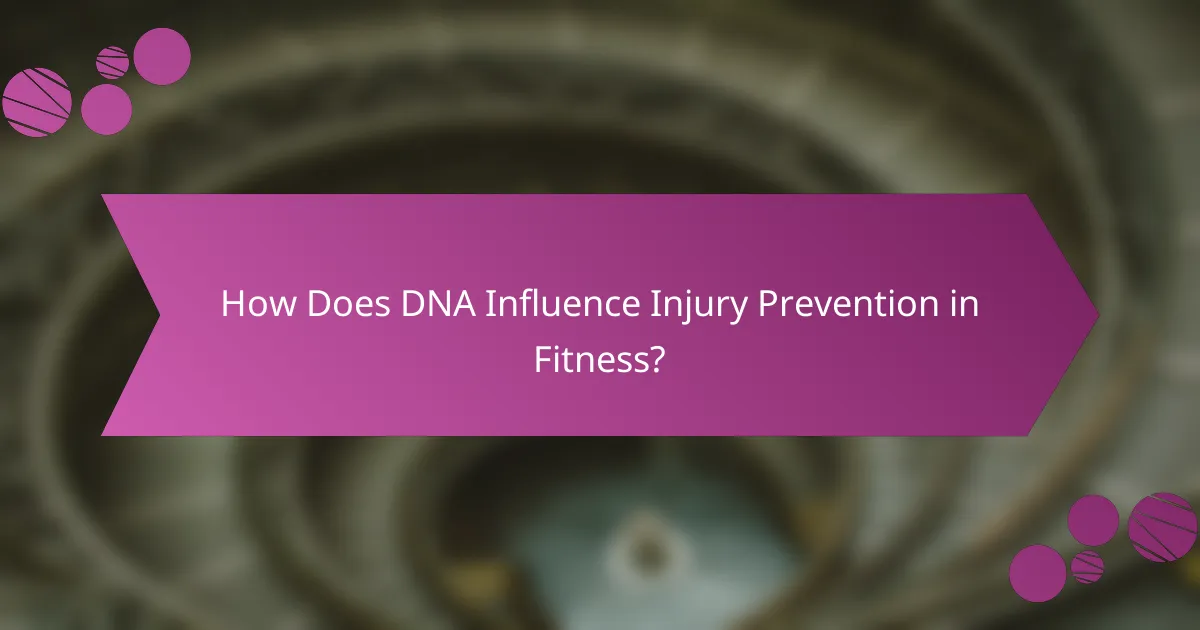DNA significantly influences fitness by affecting an individual’s risk of injury and their recovery capabilities. By analyzing genetic factors such as muscle composition and joint health, athletes can tailor their training and rehabilitation strategies to optimize performance and minimize injury risk.

How Does DNA Influence Injury Prevention in Fitness?
DNA plays a crucial role in injury prevention by determining an individual’s susceptibility to injuries and their ability to recover. Genetic factors can influence everything from muscle composition to joint health, impacting overall fitness and resilience during physical activities.
Genetic predisposition to injuries
Genetic predisposition refers to inherited traits that can make some individuals more prone to injuries than others. Variations in specific genes can affect how the body responds to physical stress, leading to a higher likelihood of strains or tears in muscles and ligaments.
For example, individuals with certain genetic markers may experience slower healing processes or a higher risk of chronic injuries. Understanding these predispositions can help athletes tailor their training and recovery strategies to minimize injury risk.
Role of collagen genes in joint health
Collagen genes are vital for maintaining joint integrity and overall musculoskeletal health. Variations in these genes can influence collagen production, which is essential for the strength and flexibility of tendons and ligaments.
Athletes with favorable collagen gene variants may have stronger joints, reducing the risk of injuries during high-impact activities. Incorporating collagen-rich foods or supplements can support joint health, especially for those with less favorable genetic profiles.
Impact of muscle fiber composition
Muscle fiber composition, determined by genetics, affects an individual’s strength, endurance, and injury risk. There are two primary types of muscle fibers: slow-twitch (Type I) and fast-twitch (Type II), each serving different physical demands.
Individuals with a higher proportion of fast-twitch fibers may excel in explosive activities but could be more susceptible to injuries due to the stress of rapid movements. Conversely, those with more slow-twitch fibers may have better endurance and a lower injury risk during prolonged activities. Tailoring training to match muscle fiber composition can enhance performance while minimizing injury risk.

What Are Effective DNA-Based Strategies for Injury Recovery?
Effective DNA-based strategies for injury recovery involve tailoring rehabilitation processes to an individual’s genetic makeup. By understanding genetic predispositions, athletes can optimize their recovery protocols and enhance overall performance.
Personalized recovery protocols
Personalized recovery protocols utilize genetic insights to create customized rehabilitation plans. These plans may include specific exercises, rest periods, and nutrition tailored to an individual’s genetic strengths and weaknesses. For example, someone with a genetic predisposition for faster muscle recovery might benefit from a more intensive training regimen post-injury.
To implement personalized protocols, consider factors such as recovery time, injury type, and genetic markers. Regular assessments can help adjust recovery strategies based on progress and response to treatment.
Genetic testing for optimal rehabilitation
Genetic testing can identify variations that influence recovery, such as those affecting inflammation and muscle repair. By understanding these genetic factors, athletes can select rehabilitation methods that align with their unique genetic profiles. For instance, individuals with certain gene variants may require longer rest periods to heal effectively.
When considering genetic testing, look for reputable services that provide insights into relevant genes. It’s advisable to consult with healthcare professionals who can interpret results and recommend appropriate rehabilitation strategies based on genetic findings.

How Can Fitness Programs Utilize Genetic Insights?
Fitness programs can leverage genetic insights to create more effective and personalized training and recovery strategies. By understanding an individual’s genetic predispositions, programs can be tailored to enhance performance while minimizing the risk of injuries.
Tailored exercise regimens
Tailored exercise regimens take into account genetic factors that influence how individuals respond to different types of training. For example, some people may have a genetic predisposition for endurance activities, while others may excel in strength training. By identifying these traits, fitness programs can focus on the most effective types of exercises for each person.
To implement tailored regimens, fitness professionals can use genetic testing to assess markers related to muscle fiber composition, recovery rates, and injury susceptibility. This data allows trainers to design workouts that align with an individual’s strengths and weaknesses, optimizing results and reducing the likelihood of overtraining.
Nutrition plans based on genetic markers
Nutrition plans informed by genetic markers can significantly enhance fitness outcomes by aligning dietary choices with an individual’s unique genetic makeup. Certain genes affect how the body metabolizes nutrients, which can influence weight management, muscle recovery, and overall health. For instance, individuals with specific genetic variants may benefit from higher protein intake to support muscle repair.
To create effective nutrition plans, fitness programs can incorporate genetic testing results that highlight optimal macronutrient ratios and food sensitivities. This personalized approach allows individuals to make informed dietary choices that complement their training regimens, ultimately leading to better performance and recovery.

What Are the Benefits of Genetic Testing for Athletes?
Genetic testing offers athletes insights into their unique biological makeup, which can inform training and recovery strategies. By understanding genetic predispositions, athletes can tailor their approaches to enhance performance and reduce injury risks.
Enhanced performance optimization
Genetic testing can identify specific traits that influence an athlete’s performance, such as muscle fiber composition and metabolic efficiency. For instance, those with a higher proportion of fast-twitch muscle fibers may excel in sprinting and power sports, while endurance athletes might benefit from a greater proportion of slow-twitch fibers.
By leveraging this information, athletes can customize their training regimens to align with their genetic strengths. For example, a sprinter might focus on explosive strength training, while a long-distance runner could prioritize aerobic conditioning. This targeted approach can lead to improved results and more efficient training sessions.
Injury risk assessment
Genetic testing can help assess an athlete’s risk of certain injuries by analyzing genetic markers associated with tissue repair and injury susceptibility. For example, variations in genes related to collagen production may indicate a higher likelihood of tendon injuries.
Understanding these risks allows athletes to implement preventive measures, such as specific strength training or flexibility exercises tailored to their genetic profile. Additionally, athletes can work with coaches and medical professionals to develop personalized recovery plans that address their unique vulnerabilities, ultimately enhancing their longevity in sports.

What Role Does Epigenetics Play in Fitness?
Epigenetics significantly influences fitness by affecting how genes are expressed in response to various environmental factors, including diet and exercise. This means that lifestyle choices can modify gene activity, impacting injury prevention and recovery processes.
Influence of lifestyle on gene expression
Lifestyle factors such as nutrition, physical activity, and stress levels can alter gene expression through epigenetic mechanisms. For instance, regular exercise can lead to beneficial changes in genes related to muscle growth and repair, enhancing overall fitness. Conversely, a sedentary lifestyle may suppress these beneficial gene expressions, increasing the risk of injury.
Diet also plays a crucial role; nutrients like omega-3 fatty acids and antioxidants can promote positive epigenetic changes that support recovery and reduce inflammation. Therefore, maintaining a balanced diet and an active lifestyle is essential for optimizing gene expression related to fitness.
Long-term adaptations to training
Long-term training induces epigenetic modifications that enhance physical performance and resilience. These adaptations can include increased muscle mass, improved cardiovascular efficiency, and better metabolic responses. Over time, consistent training can lead to permanent changes in gene expression, making the body more efficient at handling physical stress.
To maximize these adaptations, it’s important to incorporate a variety of training modalities, such as strength training, endurance workouts, and flexibility exercises. This approach not only promotes comprehensive fitness but also encourages a broader range of beneficial epigenetic changes that support injury prevention and recovery.

How Can Fitness Professionals Implement Genetic Insights?
Fitness professionals can leverage genetic insights to tailor training programs and recovery strategies for their clients. By understanding genetic predispositions, trainers can optimize workout plans and minimize injury risks.
Integrating genetic data into training
Integrating genetic data into training involves assessing clients’ genetic profiles to identify strengths and weaknesses. For instance, some individuals may have a genetic predisposition for endurance, while others may excel in strength-based activities. Trainers can use this information to customize workouts that align with each client’s unique genetic makeup.
Consider using genetic testing services that provide insights into muscle composition, recovery rates, and injury susceptibility. This data can help in creating personalized training regimens that enhance performance and reduce the likelihood of injuries.
Educating clients on genetic factors
Educating clients about genetic factors is crucial for fostering understanding and compliance. Explain how genetics can influence their fitness journey, including aspects like metabolism, recovery times, and injury risks. This knowledge empowers clients to make informed decisions about their training and recovery.
Provide resources or workshops that delve into genetic influences on fitness. Use simple language and examples to clarify complex concepts, ensuring clients grasp how their genetic background can shape their fitness outcomes. Encourage open discussions to address any questions or concerns they may have.

What Are the Limitations of DNA Testing in Fitness?
DNA testing in fitness has limitations, including the inability to provide a complete picture of an individual’s fitness potential and the influence of environmental factors. While genetic information can offer insights into predispositions for certain traits, it cannot account for lifestyle choices, training methods, or nutrition, which are crucial for achieving fitness goals.
Understanding the complexity of gene-environment interactions
Gene-environment interactions are complex and can significantly influence fitness outcomes. For example, an individual may have a genetic predisposition for muscle growth, but without proper training and nutrition, those genes may not express their full potential. Environmental factors like diet, exercise habits, and even stress levels play a critical role in how genes affect fitness.
Moreover, the impact of these interactions can vary widely among individuals. Some may respond exceptionally well to specific training regimens due to their genetic makeup, while others may not see the same results despite similar efforts. This variability underscores the importance of a personalized approach to fitness that considers both genetic and environmental factors.
Ethical considerations in genetic testing
Ethical considerations surrounding genetic testing for fitness include privacy concerns and the potential for discrimination. Individuals may worry about how their genetic information could be used by insurance companies or employers, leading to unfair treatment based on genetic predispositions. Ensuring confidentiality and informed consent is essential in addressing these concerns.
Additionally, there is the risk of overemphasizing genetic factors while downplaying the importance of personal effort and lifestyle choices. This could lead to a deterministic mindset, where individuals feel powerless to change their fitness outcomes despite their environment and behaviors. Promoting a balanced view that recognizes both genetics and personal agency is crucial in the conversation about fitness and genetic testing.

